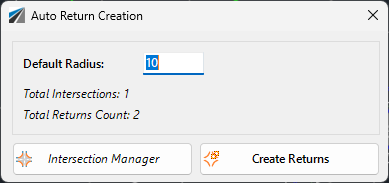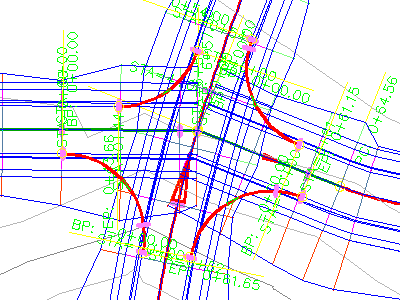Auto Curb Returns
Icon: ![]()
![]()
Introduction
This command undertakes the following tasks automatically:
- Scans the drawing for all intersection Main and Side Roads (defined from alignments with prefix r- in the description and created using the
 Create/Edit Roads or
Create/Edit Roads or  Auto Create Roads commands)
Auto Create Roads commands) - Locates the edge of each road (by reading the Label from the road cross sections assigned as the connection point in the
 Active Drawing Settings form)
Active Drawing Settings form) - Creates alignments of a specified radius to match to the edge of the Main and Side Roads and maintain tangency relative to the Road centerline alignment, using Civil 3D styles set by the designer
- Automatically generates a Curb Return road object. The Design profile matches the incoming and outgoing elevations and grades and includes parabolic vertical curve/s through the curb return to form a smooth profile.
The designer can control the default radius assigned to the curbs at the time of running the command and also from the ![]() Active Drawing Settings. Radius can be set at each interesection and return by using the Intersection Manager.
Active Drawing Settings. Radius can be set at each interesection and return by using the Intersection Manager.
This command assumes that the Roads have been created (not necessarily the final designed profile).
After the curb returns have been created users can:
- Use the Intersection Manager to edit and manage each intersection and curb returns
- Edit the start/end of the curb returns by changing the profile of the Main and/or Side roads via the
 Create/Edit Roads command
Create/Edit Roads command - Change the automatic redesign options for the curb return/s by editing the
 Curb Design Controls
Curb Design Controls - Change the radius of any curb return using the
 Create/Edit Curb Return command
Create/Edit Curb Return command
Details
Upon selecting the command the following form is displayed:
 |
|
| Default Radius | Type in the required default radius to be applied to all curb returns that have not already been created. |
| [List] | Lists the total intersections detected as well as the total curb return count. |
| Intersection Manager | Opens the Intersection Manager to review all intersections before creation. |
| Create Returns | Creates all curb returns at all Road intersections |
The command is fully automated - the software includes it's own algorithm for locating the connection points on the main and side road corridors at the edge of each road, using the road centerline for directions start and end.
Note: Given the iterative nature of the command, designers must provide Road lengths in everydirection from the intersection point to be AT LEAST two sampled sections beyond the extents of the curb return start/end, to provide the software with a reasonable starting point to iterate from.
After Running the Command:
 |
Alignments are created to connect the edge of the Main and Side Roads at every quadrant.
The radius of each return, and whether to include curb returns at intersections, can be set in the Intersection Manager prior to creation. In the example shown the thick red lines represent the curb return alignments created by the software. Use the |